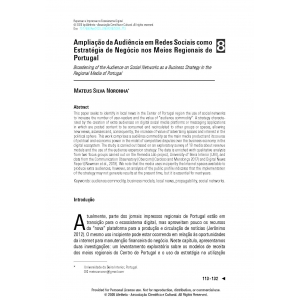Aguado, J., & Castellet, A (2013). “Periodismo móvil e información ubicua”. in La comunicación móvil: hacia un nuevo sistema digital (pp. 187-214). Barcelona: Gedisa.
Aroldi, P, & Colombo, F. (2007). “Generational Belonging and Mediascape in Europe”. JSSE - Journal of Social Science Education 1-2007: Europe as an Educational Framework: Cultures:475 kB.
Bolaño, C. (2000). Indústria cultural, informação e capitalismo. São Paulo: Hucitec/Polis.
Bolaño, C., & Vieira, E. (2015). “The Political Economy of the Internet: Social Networking Sites and a Reply to Fuchs”. Television & New Media 16(1):52–61.
Cardoso, G. & Mendonça, S. (2017). Relatórios Obercom. Pesquisa de Público. Portugal: Obercom - Observatório da Comunicação.
Castells, M. (2008). A sociedade em rede. São Paulo: Paz e Terra.
Castells, M. (2009). Comunicación y poder. 1. ed. Madrid: Alianza.
Dantas, M. (2014). “Mais-Valia 2.0: produção e apropriação de valor nas redes do capital”. Revista Eptic Online 16(2):89–112.
Fuchs, C. (2015). “Against Divisiveness: Digital Workers of the World Unite! A Rejoinder to César Bolaño and Eloy Vieira”. Television & New Media 16(1):62–71.
Fuchs, C. (2018). “Universal Alienation, Formal and Real Subsumption of Society uder Capital, Ongoing Primitive Accumulation by Dispossession: Reflections on the Marx@200-Contributions by David Harvey and Michael Hardt/Toni Negri”. Triple C, 454–67.
Fuchs, C. (2012). “Dallas Smythe today - the audience commodity, the digital labour debate, marxist political economy and critical theory. Prolegomena to a Digital Labour Theory of Value”. Triple C 10(2):692–740.
Gomes, T & Costa, G. (2016). “Caça-cliques no jornalismo: 5 padrões de títulos para atrair leitores no Facebook”. Temática, 60–75.
Goyanes, M & Dürrenberg, C. (2014). “A Taxonomy of Newspapers Based on Multi-Platform and Paid Content Strategies: Evidences from Spain”. International Journal on Media Management 16(1):27–45.
Grohmann, R. (2014). “Audiência como mercadoria na Internet: comunicação, convergência e trabalho”. P. 3189–97 in Comunicação ibero-americana: os desafios da Internacionalização. Minho: Universidade do Minho.
Jenkins, H., Ford, S & Joshua, G. (2015). Cultura da conexão [livro eletrônico] : criando valor e significado por meio da mídia propagável. 1o ed. São Paulo: Aleph.
Jerônimo, P. (2012). “Origens e evolução do Ciberjornalismo de proximidade em Portugal: O caso da imprensa regional”. P. 81–86 in Ágora: jornalismo de proximidade: limites, desafios e oportunidades. Covilhã: LabCom Books.
Lawless, B & Chen, Y. (2019). “Developing a Method of Critical Thematic Analysis for Qualitative Communication Inquiry”. Howard Journal of Communications 30(1):92–106.
Mosco, V. (2009). La economía política de la comunicación: reformulación y renovación. Barcelona: Bosch.
Murdock, G. (2005). “Continental shifts: capitalism, communications and change in Europe”. Comunicação e Sociedade, 11–23.
Murdock, G & Golding, P. (1973). “For a Political Economy of Mass Communications”. The Socialist Regiter 1973 10:205–34.
Napoli, P. M. (2011). Audience evolution: new technologies and the transformation of media audiences. New York: Columbia University Press.
Newman, N., Fletcher, R & Nielsen, R. (2019). “Digital News Report”. Digital News Report. Recuperado 7 de abril de 2020 (http://www.digitalnewsreport.org).
Recuero, R. (2006). “Comunidades virtuais em redes sociais na internet: proposta de tipologia baseada no fotolog.com”. Universidade Federal do Rio Grande do Sul, Porto Alegre-RS.
Smythe, D. (1977). “Communications: blindspot of western marxism”. Canadian Journal of Political and Social Theory 1(3):1–28.
Sousa, H. (2005). “Economia política da comunicação e dos media: novos cruzamentos e triangulações”. Comunicação e Sociedade, 5–8.
Zago, G. (2017). “A participação do público na recirculação jornalística em sites de rede social: implicações para o jornalismo”. Rizoma, dezembro, 88–104.









